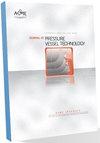不锈钢内衬复合管热液膨胀过程的理论研究
IF 1.4
4区 工程技术
Q4 ENGINEERING, MECHANICAL
Journal of Pressure Vessel Technology-Transactions of the Asme
Pub Date : 2022-05-12
DOI:10.1115/1.4054545
引用次数: 1
摘要
不锈钢内衬复合管(SSLCP)可广泛应用于不同领域。工业SSLCP通常采用冷液压膨胀(CHE)方法制造,该方法要求高液压和良好的密封性能。当内外管的屈服强度之间几乎没有差异时,CHE很难获得层间结合力。此外,当内管的屈服强度高于外管时,几乎不能实现水力膨胀过程。热液压膨胀(The)方法可以克服这些困难。本文采用图解法分析了“内强外弱(ISOW)”和“外强内弱(OSIW)”管道的the原理。提出了SSLCP的有效水力膨胀准则条件,可作为复合管材料匹配和成型工艺选择的依据。通过对the过程中内外管的应力应变分析,建立了内外管弹性变形和热变形的变形协调条件。残余接触压力p*c、液压膨胀压力pi和有效温差之间的相关性?Te。得到了最大膨胀压力pimax和最小膨胀压力pimin的计算公式。导出了外管的最高加热温度。此外,采用有限元分析方法,仿真结果验证了理论研究的可行性和适用性。本文章由计算机程序翻译,如有差异,请以英文原文为准。
Theoretical Study On Thermal Hydraulic Expansion Process of Stainless Steel Lined Clad Pipe
The stainless steel lined clad pipe (SSLCP) can be widely used in different fields. Industrial SSLCP are generally manufactured by the cold hydraulic expansion (CHE) method which requires high hydraulic pressure and good sealing property. The inter-layer bonding force is difficult to obtain by the CHE when there is little difference between the yield strengths of inner and outer pipes. Furthermore, the hydraulic expansion process nearly can not be achieved when the yield strength of inner pipe is higher than that of outer pipe. The thermal hydraulic expansion (THE) method can overcome these difficulties. In this paper, the graph method was adopted to analyze the THE principles for "inner strong and outer weak (ISOW)" and "outer strong and inner weak (OSIW)" pipes. The effective hydraulic expansion criterion conditions of SSLCPs were proposed and can be used as basis of clad pipe material matching and forming process selection. Through the stress and strain analysis of inner and outer pipes during THE process, the deformation coordination conditions of elastic deformation and thermal deformation of the inner and outer pipe were established. The correlation between the residual contact pressure p*c, the hydraulic expansion pressure pi and the effective temperature difference ?Te were derived. The calculation formula of the maximum expansion pressure pimax and the minimum expansion pressure pimin was obtained. The maximum heating temperature of outer pipe was also derived. Furthermore, the finite element analysis (FEA) method was adopted and simulated results verify the feasibility and applicability of the theory study.
求助全文
通过发布文献求助,成功后即可免费获取论文全文。
去求助
来源期刊
CiteScore
2.10
自引率
10.00%
发文量
77
审稿时长
4.2 months
期刊介绍:
The Journal of Pressure Vessel Technology is the premier publication for the highest-quality research and interpretive reports on the design, analysis, materials, fabrication, construction, inspection, operation, and failure prevention of pressure vessels, piping, pipelines, power and heating boilers, heat exchangers, reaction vessels, pumps, valves, and other pressure and temperature-bearing components, as well as the nondestructive evaluation of critical components in mechanical engineering applications. Not only does the Journal cover all topics dealing with the design and analysis of pressure vessels, piping, and components, but it also contains discussions of their related codes and standards.
Applicable pressure technology areas of interest include: Dynamic and seismic analysis; Equipment qualification; Fabrication; Welding processes and integrity; Operation of vessels and piping; Fatigue and fracture prediction; Finite and boundary element methods; Fluid-structure interaction; High pressure engineering; Elevated temperature analysis and design; Inelastic analysis; Life extension; Lifeline earthquake engineering; PVP materials and their property databases; NDE; safety and reliability; Verification and qualification of software.

 求助内容:
求助内容: 应助结果提醒方式:
应助结果提醒方式:


